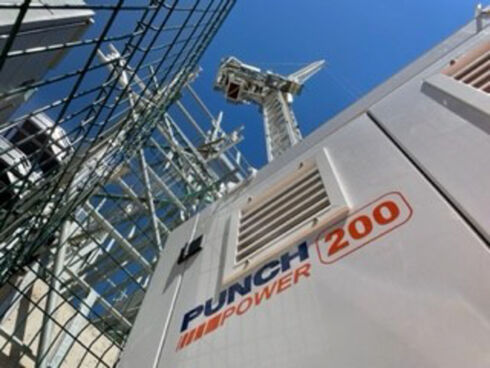
Flywheel system saves energy for HS2
22 August 2022

HS2 is using the innovative Punch Flybrid device to reduce energy usage and emissions at one of its London construction sites.
The technology, which was deployed in Formula 1 and at Le Mans, has halved the diesel used by a tower crane at the railway’s Euston approaches site where the tunnels surface.
The crane would normally be powered by a 500kVA diesel generator to lift loads of up to 24 tonnes, but the Flybrid is enabling a 200kVA machine to be used.
The power difference is bridged by pairing it with the energy storing flywheel system, which is also being used by other contractors at a number of sites, as previously reported on the blog.
Incorporated inside the Punch Flybrid-supplied unit, the flywheel measured just 35cm in diameter and is housed in a vacuum chamber to all but eliminate air resistance.
The technology matches the power of larger generators by harnessing the 200kVA unit’s surplus power during the crane’s low-load periods to charge the spinning flywheel to very high speeds, equivalent to a ground speed of 550mph. The kinetic energy stored by the flywheel can then be quickly released to support the generator when the crane demands maximum power to lift heavy loads.
Silverstone-based Punch Flybrid’s expertise was originally deployed in F1 motor sport and was subsequently put through its paces in endurance racing, including the famous Le Mans 24 Hour, before both sports opted to focus exclusively on electric battery-based hybrid technology.
Able to perform up to 10 million charging cycles compared to 3,000 of a typical electric vehicle battery, the flywheel is proving to be a sustainable way of meeting extreme and repetitive construction site demands.
In May 2022 the Euston trial more than halved the diesel consumption of a single tower crane to 6.3 litres per hour, saving 4.8 tonnes of carbon – equivalent to the average monthly CO2 emissions of 40 family cars.
Tobias Knichel, Punch Flybrid MD, said: “Racing cars typically accelerate and brake around 500 times during a 90 minute F1 Grand Prix. Each time the car brakes into a corner at high power our flywheel system spins up, storing energy which is then released quickly to boost acceleration performance as the car leaves a bend.”
The system is designed to also work with hydrogen, mains electricity and battery-powered generators.

